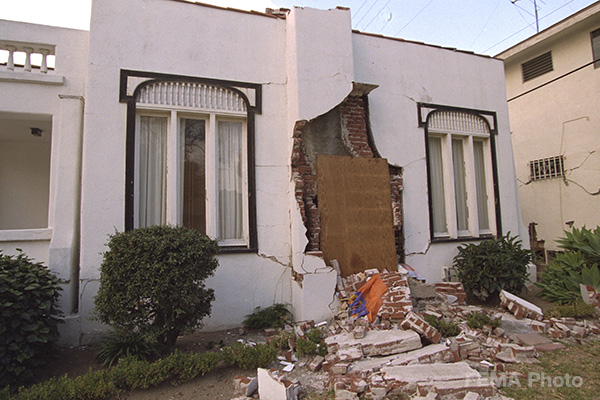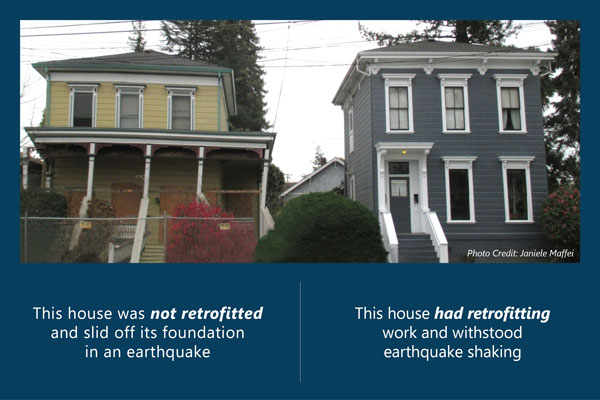Ready for some earthquake damage facts? Earthquake shaking can literally move a house off its foundation or, with some types of structures, can even cause collapse. Items inside a house, such as cabinet doors and entry doors can wildly swing open, glass doors and windows can shatter, pipes can burst, heavy furniture can topple, light fixtures can wobble and fall. Bottom line? The extent of potential earthquake damage and earthquake destruction to a home may be catastrophic.
And, outside your home, roof frames can collapse, power lines can fall to the ground and natural gas lines can rupture. The same shaking can also lead to ground surface rupture, tsunamis, liquefaction, landslides and fires.
In California, homes that are particularly susceptible to earthquake shaking are those built before 1980 when meaningful seismic building codes went into effect. Also vulnerable are those homes that have a large opening, like a garage door, on the first floor. Learn more at this homeowner site that provides even more details about the potential for damage caused by earthquakes to your home.
Rooms over garages are susceptible to quake damage
According to the Earthquake Country Alliance, the large opening of a garage door and the weight of a second-story room built over the garage can result in the walls being too weak to withstand earthquake shaking. When the narrow sections of the wall on each side of the opening are not reinforced and braced, the weakness is worse. Many of these so-called “soft stories” are perfect candidates for seismic retrofitting.
Damage to windows from earthquake shaking
The windows of your home are also vulnerable to earthquake shaking and earthquake damage. If your home has large windows, the glass may break when the ground shakes, especially if there are only narrow walls on each side of the windows.
According to the Federal Emergency Management Agency (FEMA), tempered glass may fare best when it comes to earthquake shaking because it breaks into smaller fragments rather than large shards. There are films that can be put on non-tempered glass that provide some protection.
If you are inside your home or a building during an earthquake, the best and safest thing to do is move away from glass windows, if possible, and get under a desk or table to protect yourself.
Masonry work can sustain damage from quakes
Houses built of unreinforced masonry, which include bricks, hollow clay tiles, concrete blocks or adobe, are very likely to sustain earthquake damage. The Earthquake Country Alliance also points out that the mortar holding the masonry together generally is not strong enough to resist the destructive effects of earthquakes.
Chimneys are vulnerable to tremblers
In the 1994 Northridge earthquake in the San Fernando Valley near Los Angeles, an estimated 15,000 chimneys sustained damage. Brick chimneys, particularly those that are unreinforced or lightly reinforced, are especially vulnerable to earthquake shaking. If your home has a brick chimney, it’s best to protect your roof by adding a layer of plywood sheathing. Despite their popularity with homeowners, chimneys do not do well in earthquakes and falling chimneys also pose a threat to people on the ground.
Determine your home's structural risks
No part of the Golden State is immune from seismic activity from earthquakes. However, there are steps you can take to prepare your home to reduce its risk of structural damage.
How can retrofitting help strengthen your home in case of an earthquake?
For many of us who live in California in homes built before 1980, there is a way to strengthen a house by making it more resistant to earthquake shaking and damage with a seismic retrofit. It was not until 1980 in California that the first meaningful seismic codes for houses were introduced. Seismic codes have continued to be improved every three years. The frames of many pre-1980 built homes are not bolted to their foundations, which means they can slide off their foundations during the violent shaking caused by a large earthquake.
Why should you consider a seismic retrofit for your house?
A seismic retrofit is the process of strengthening your home by making it less vulnerable to earthquake damage. This could be as simple as installing plywood or steel panels on garage doors or bracing and bolting the frame of your home to the foundation within the crawl space or cripple wall. What’s more, this seismic retrofitting process can provide peace of mind, knowing that you have proactively taken steps to protect your family and your property.
What is the average cost of earthquake damage to a home?
According to HomeAdvisor, the cost for repairing earthquake damage to a house runs the gamut and is driven by the extent of damage to the dwelling. Costs can range from a few thousand dollars for relatively minor, emergency repairs to hundreds of thousands of dollars for extensively damaged, non-retrofitted homes. Seismic retrofitting as described above could potentially save homeowners thousands of dollars in repair costs.
The financial benefits of code-compliant retrofitting are demonstrated in a 2020 research project coordinated by the Pacific Earthquake Engineering Research (PEER) Center. Among its findings, the PEER study estimated potential savings of between $10,000 and $200,000 for the owners of code-compliant, retrofitted homes after a major earthquake.
What is the average cost of a seismic retrofit?
HomeAdvisor suggests that the average cost of a seismic retrofit ranges between $3,400 and $7,500, but they note that the exact cost depends on many factors, including which state the home is in, the type of construction, the extent and scope of the work that needs to be done, and the size of the structure that needs to be retrofitted. Larger homes, those with rooms over garages and those built on hillsides are examples of homes that can often cost more to retrofit.
According to the Earthquake Brace + Bolt (EBB) program, which has helped fund more than 16,000 code-compliant brace and bolt seismic retrofits since 2016, the average cost of those retrofits is $6,166, with nearly half of those completed retrofits costing less than $5,000. Another advantage of a code-compliant seismic retrofit is that it could result in an earthquake insurance premium discount. Check with your insurance company to see if you are eligible for such a discount.
What is your earthquake risk?
While U.S. Geological Survey scientists say there is more than a 99 percent chance of at least one magnitude 6.7 or greater earthquakes occurring over a 30-year period in the Golden State, the specific risk you face from a major earthquake is based on where in the state of California you live in.*
Whether you live in the San Francisco area, the Los Angeles area, the Central Valley or anywhere in California, it is not a question of if, but rather when, the next big one will rattle some part of the Golden State. So why not be better prepared to protect your family, your home and your future by strengthening your home against earthquake damage!
There are ways you can protect your home and your family in the event of a major earthquake. Learn more at our blog on Essential Earthquake Safety Tips at Home.
And, if you live in California and your house was built before 1980, earthquake experts say your dwelling is especially vulnerable to damage from earthquake shaking because it was built before modern seismic building codes were put in place. The frames of hundreds of thousands of these types of homes are not bolted to their foundations. And without adequate bracing (when needed) and bolting, these houses can slide or topple off their foundation during an earthquake.
For many California homeowners, the value of their property and the equity they have in it represent the majority of their savings and retirement nest egg. A seismic retrofit can significantly reduce the chances of an older home falling or sliding completely off its foundation—perhaps resulting in a total loss, even in a moderate earthquake.
Learn more about retrofitting for your house type at our Strengthen Your House page.
*According to the third Uniform California Earthquake Rupture Forecast (UCERF3) report.


